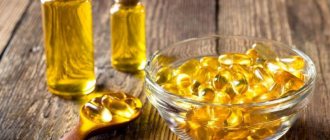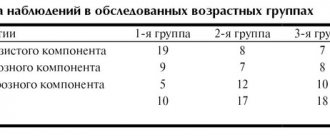Average reading time: 8 minutes
Publication date: August 09, 2021
Zakharova Carolina Yurievna
Physician and author of scientific articles on therapy, ophthalmology, pediatrics and psychiatry
The mark “37” on the thermometer can cause many questions. Should I be worried or is this normal? Or maybe it’s time to take antipyretics? Let's figure out what causes a slight fever and what should be done.
Up to contents
Why does the temperature rise to 37 °C?
Body temperature is not a constant value, it fluctuates during the day within the range of 0.1 -0.6 ° C, in the morning it is usually lower than in the evening1. Therefore, the norm may be within 36-37 °C1.
However, the method of measurement must be taken into account. Typically, body temperature is determined in the armpit, and here its optimal value is considered to be 36.6 °C1. And if you use a rectal thermometer and measure body temperature in the rectum, remember that here it is normally 0.5-1.0 °C higher than under the armpit1.
When the thermometer records a temperature between 37°C and 38°C (when measured in the armpit), this is already a fever1, but since it is not pronounced, it is called subfebrile3.
The term “subfebrile” comes from the words sub – “under, to a weak degree” and febris – “fever”3. Low-grade fever that lasts a long time is called low-grade fever3.
Depending on the severity, subfebrile condition is distinguished2:
- ● low – up to 37.1 °C;
- ● high – up to 38.0 °С2.
Despite the variety of causes, in 70-75% of cases, an increase in temperature to 37-38 ° C is caused by infection2. Infectious agents, such as viruses and bacteria, act as pyrogens4 - substances that rearrange the functioning of the thermoregulation center in the brain (hypothalamus). In this center, two areas are separately distinguished: heat production and heat transfer1,4. Under the influence of pyrogens, the balance of heat production and heat loss is disrupted, which leads to fever1,4.
Up to contents
Reduced body temperature
Like high temperatures, low temperatures also indicate problems. Especially if it lasts for a long time. This leads to rapid fatigue, loss of mood, weakness of the body, etc.
Causes of low body temperature
A decrease in temperature is observed:
- with low hemoglobin;
- in case of internal bleeding;
- during pregnancy;
- if there are problems with blood vessels;
- for diabetes;
- with pathology of the adrenal glands;
- during brain tumors;
- with asthenic syndrome;
- during skin lesions;
- as a result of seasonal ARVI;
- in case of intoxication;
- as a consequence of hypothermia;
- with hypothermia.
Symptoms of low body temperature
Symptoms include:
- weakness;
- drowsiness;
- apathy;
- chills;
- feeling of cold.
Causes of temperature 37 °C without cold symptoms
Sometimes the rise in temperature is not associated with the action of viral and bacterial pyrogens; this condition is called hyperthermia1.
Mild hyperthermia may occur in healthy people1:
- ● during intense physical activity1;
- ● after meals1;
- ● against the background of severe stress (“workday hyperthermia” in adults)3;
- ● in hot weather1 and prolonged exposure to the sun2;
- ● as a side effect of taking certain medications1.
In women, a temperature of 37 °C can occur after ovulation5 and 7-10 days before the onset of menstruation6. This temperature reaction is associated with an increase in the level of the hormone progesterone5.
Pyrogens that are formed in the body itself can also affect the thermoregulation center, which is why low-grade fever often occurs with non-infectious diseases4.
For example, a temperature of 37 °C may be a sign
:
- ● neurogenic hyperthermia4, which is associated with imperfect nervous regulation4,7;
- ● iron deficiency anemia2 (low hemoglobin levels due to iron deficiency);
- ● chronic gastritis, hepatitis and colitis2;
- ● peptic ulcer of the stomach and duodenum2;
- ● urolithiasis and cholelithiasis1;
- ● the presence of foci of inflammation in the body (for example, in the bronchi or genitourinary organs)2;
- ● bronchial asthma2;
- ● autoimmune diseases2;
- ● hormonal imbalance (with menopausal syndrome or increased thyroid function)6;
- ● malignant process2;
- ● diseases of the hypothalamus2.
Up to contents
What can cause a fever?
So, first, let's figure out what low-grade fever is. In the literature, this is what is called a temperature above 37.4, but below 38 degrees, although more often this concept means a fever that “hovered” at the numbers 37.3 - 37.7, and we are not talking about a one-time increase in temperature, but about regular disturbances in the temperature curve. Another feature of low-grade fever is that most often a person does not feel his temperature, that is, he does not have the symptoms that we often experience when the numbers increase:
- headache;
- chills or fever;
- aching bones;
- weakness;
- sweating
He may feel well, go to work, live a normal life and experience only weakness and malaise. Often a person finds out about his low-grade fever by accident when he decides to take his temperature.
Is it necessary to bring down the temperature of 37 °C in an adult?
Fever itself is a protective reaction of the body8, so antipyretic drugs should be taken only as indicated - for adults at a temperature above 38.5 °C and/or muscle and joint pain due to ARVI12.
For ARVI it is recommended12:
- ● bed rest;
- ● drinking plenty of water;
- ● a diet rich in vitamins;
- ● symptomatic treatment (to relieve nasal congestion, cough and other symptoms of a cold);
- ● taking antiviral drugs.
Anaferon®11 lozenges can be used as part of complex therapy for ARVI. The active ingredient of the drug is antibodies to interferon gamma. Their antiviral and immunomodulatory effects are associated with the activation of natural immune factors that help the body fight viruses11,13. Anaferon ® is indicated for the treatment of influenza and other acute respiratory viral infections11. Its use as part of complex therapy helps reduce the duration of the main symptoms of the disease by 1.5 times or more13. Also, Anaferon ® can be used during the ARVI epidemic season as a prophylactic agent for 3 months11.
Up to contents
Treatment
Help before diagnosis
With elevated low-grade fever that lasts less than 2 days, specific treatment is not required. A long duration of symptoms indicates the presence of a pathological process, which is an indication for seeking medical help. Until the cause of the fever is determined, the patient should be given plenty of warm fluids. Physical cooling methods are used - rubbing, cold compresses. It is recommended for adults to drink antipyretics to bring down the temperature when the thermometer readings are more than 38.5 ° C; children are given antipyretics when the temperature is above 38 degrees.
Conservative therapy
Medical tactics depend on the cause of symptoms and the general condition of the patient. In case of high fever, temperature measurements in the hospital are carried out every 2-3 hours to assess the dynamics. In children, impaired thermoregulation is sometimes accompanied by convulsions, so when an elevated febrile temperature is detected, they are immediately given antipyretic medications. A prerequisite is adequate etiotropic and pathogenetic therapy, against the background of which thermometry indicators are normalized. For therapeutic purposes use:
- Antibiotics
. Medicines are selected empirically, the treatment regimen is adjusted after receiving the culture results. For massive purulent processes, combinations of 2 or 3 drugs are recommended, which are administered parenterally in high therapeutic doses. - Antiviral agents
. For influenza, specific medications are indicated to block the multiplication of the virus and speed up recovery. For the treatment of viral hepatitis, medications have been developed that reduce the viral load and alleviate the general condition. - Anti-inflammatory drugs
. Nonsteroidal drugs block the synthesis of prostaglandins and cytokines acting on the thermoregulatory center and reduce the activity of the inflammatory process. NSAIDs are used that have powerful antipyretic properties. - Glucocorticoids
. Prescribed for severe systemic autoimmune or allergic reactions that do not respond to other therapy. They are used with caution for infections, since adrenal hormones suppress the activity of the immune system. - Infusion solutions
. If the temperature is above 38° C and the patient’s condition is serious, rehydration and detoxification therapy are required. Saline solutions containing essential electrolytes are poured in. Treatment is supplemented with diuretics. - Vitamins
. In case of sluggish processes, ascorbic acid and B vitamins are used to stimulate the immune system. Metabolic drugs that improve metabolic processes in cells and have a tonic effect are effective. The products are combined with antioxidants.
Surgery
If large abscesses or foci of osteomyelitis are detected, they must be drained and the resulting cavities must be washed with antiseptic solutions. For diseases manifested by an “acute abdomen,” abdominal surgery with wide access is indicated to remove altered areas of the intestine, followed by sanitation of the abdominal cavity. For malignant tumors, radical surgical interventions are performed (removal of the tumor along with the surrounding tissue and regional lymph nodes), combined with radiation and chemotherapy.
Temperature 37 °C in children
Many of the causes of hyperthermia in a child are the same as in an adult. For example, children can overheat in the sun in hot weather; their nervous system, which controls the processes of heat production and heat transfer, may also be disrupted3.
In most cases, the child develops a so-called post-infectious low-grade fever, which is associated with a recent acute respiratory viral infection.
In 86% of children, low-grade fever may persist for 3-6 months after viral infection3.
Often a child has a body temperature of 37 °C for no apparent reason. This is the so-called institutional fever or “thermoneurosis”3. With “thermoneurosis,” the child usually tolerates the fever well. Parents may notice that antipyretic drugs do not give the desired effect, and the rise in body temperature is associated with psycho-emotional stress, for example, the stress that the child experiences at school3.
Up to contents
How does the temperature rise and how long does it last for the flu?
The infection begins acutely with an increase in temperature. The patient feels chills. This is the contraction of small fibers of skeletal muscles, “producing” heat. Pyrogens act on the brain, causing a subjective feeling of cold. A person who is just getting sick with the flu is trying to warm up. Peripheral vessels narrow to reduce heat transfer. The patient notices how his hands and feet become cold.
When the temperature reaches high values, the vessels begin to expand. The chills stop and the person feels “hot.” His face turns red and sweating increases (this is the so-called “red” hyperthermia). In most patients with influenza, the fever stops at 38-39 degrees, there are no pronounced disturbances in thermoregulation. When answering the question of how long the flu fever usually lasts in such cases, infectious disease specialists point to an interval of 2 to 5 days.
On days 2-4, a cough develops, which signals that the trachea has been infected by the virus. If the immune system is weak, a secondary infection may occur. In this case, the temperature will last longer.
In more severe cases, the temperature rises to 39-40 °C within several hours. Disturbances in thermoregulation occur when, even against the background of fever, the body continues to “think” that it is cold, and heat production begins to significantly dominate over heat transfer. The arteries remain in a narrowed state, and overheating (“white” hyperthermia) develops. In addition, the influenza virus also affects the vascular walls, disrupting microcirculation, which primarily affects the brain. This condition poses a threat to the life and health of the patient and requires immediate hospitalization. It is difficult to predict how long the flu with such symptoms will last, and how long the fever will persist.
Is it worth lowering a child’s temperature to 37°C?
Children usually have a higher body temperature than an adult1, so do not rush to give your child antipyretics.
Symptomatic treatment with antipyretic drugs is indicated when8:
- ● body temperature above 39.0 °C in children of any age;
- ● fever above 38 °C in children under 3 months or if the child has severe concomitant diseases, for example, damage to the cardiovascular and nervous systems;
- ● “white” fever, in which the skin becomes cold, pale, and a “marble” pattern appears on it.
In other cases, it is not recommended to reduce a child’s fever. In addition, it should be borne in mind that fever itself activates the immune system in the fight against infection4. For ARVI in children, to support immunity, the doctor may recommend Anaferon ® for children in the form of lozenges or drops for oral administration9,10.
Anaferon ® for children is approved for use in children from 1 month of age as part of complex therapy for ARVI. It stimulates the immune system, promotes the production of antibodies and increases the functional activity of immune cells9,10. Also, Anaferon ® for children can be used for the prevention of ARVI9,10 due to its ability to maintain the child’s body in a state of high readiness for protection against viruses14.
Up to contents
How to lower an adult's fever: 8 best drugs
September 14, 2022
37486
4.2
1
Content
- How to choose fever pills
- Why does the temperature rise
- What to do at elevated temperatures
- How to reduce fever without medication
- The best antipyretics
- Paracetamol
- Nimesil
- Nurofen Long
- Theraflu ExtraTab
- Ibuklin
- Maxicold
- Rinza
- Aspirin
An increase in temperature is a signal from the body that there is an inflammatory process somewhere. An increase in temperature is a protective response of the immune system, the purpose of which is to eliminate the problem. But there are situations when the temperature urgently needs to be brought down. We will tell you which antipyretic pills are best to choose.
Paracetamol
You can buy Paracetamol in tablets, capsules, syrup, suspension and in the form of rectal suppositories. The active substance is paracetamol. The antipyretic is available without a prescription. This is the safest remedy, effective and prescribed for ARVI. Compared to other drugs, Paracetamol is weaker because it does not have an anti-inflammatory effect - for bacterial infections it is better to choose other tablets for fever. Paracetamol moderately reduces headaches and reduces general malaise. The temperature begins to drop 30-40 minutes after taking the drug, the effect lasts for 4-6 hours. Paracetamol is safe for both children and the elderly, pregnant and lactating women. The only exception is people with severe liver disease and chronic alcoholism. Paracetamol should not be taken with alcohol, for prophylaxis or as a course - only at high temperatures.
Paracetamol MS
Medisorb, Russia
Paracetamol is used for: relieving moderate or mild pain (headache, toothache, migraine, sore throat, neuralgia, myalgia);
reducing elevated body temperature during colds and other infectious and inflammatory diseases. Paracetamol is intended for symptomatic therapy, reducing pain and inflammation at the time of use, does not affect the progression of the disease. from 2
5.0 1 review
373
- Like
- Write a review
Ibuklin
This is a complex antipyretic drug - here paracetamol and ibuprofen (antipyretic and NSAID). You can buy Ibuklin without a prescription; the product reduces fever well, relieves cold symptoms, reduces inflammation and body aches, and improves overall well-being. “Ibuklin” begins to act 20 minutes after administration, and the effect lasts 6-8 hours. Contraindications: liver and kidney diseases, gastrointestinal problems (ulcers, gastritis). Ibuklin should not be taken with alcohol.
Ibuklin
Dr. Reddy's Laboratories, India
- symptomatic treatment of infectious and inflammatory diseases (colds, flu), accompanied by fever, chills, headache, muscle and joint pain, sore throat;
- myalgia; - neuralgia; - back pain; — joint pain, pain syndrome in inflammatory and degenerative diseases of the musculoskeletal system; - pain from bruises, sprains, dislocations, fractures; — post-traumatic and postoperative pain syndrome; - toothache; - algodismenorrhea. The drug is intended for symptomatic therapy, reducing pain and inflammation at the time of use, and does not affect the progression of the disease. from 78
842
- Like
- Write a review
Nimesil
The active ingredient of the antipyretic drug is nimesulide. These are NSAIDs with pronounced anti-inflammatory, antipyretic and analgesic effects. You can buy Nimesil at the pharmacy in individual sachets. Among the contraindications to taking Nimesil are diseases of the gastrointestinal tract (the full list is listed in the instructions, so be sure to read it before taking the drug). "Nimesil" should be used only after consultation with a doctor.
Nimesil
Berlin-Chemie/Menarini, Germany
Treatment of acute pain (back pain, lower back pain; pain syndrome in the musculoskeletal system, including injuries, sprains and dislocations of joints, tendonitis, bursitis; toothache);
— symptomatic treatment of osteoarthritis with pain syndrome; - algodismenorrhea. The drug is intended for symptomatic therapy, reducing pain and inflammation at the time of use. from 24
5.0 2 reviews
1924
- Like
- Write a review
What to do at elevated temperatures
If you have a slight fever, do not rush to immediately swallow an antipyretic. If the numbers are 38-38.5, just try to have a good rest, drink a lot of warm liquids and get some sleep. Give the body the opportunity to cope with the infection on its own.
If you feel normal at an elevated temperature (up to 38.5 degrees), you are at home, you can try to lower the temperature without pills: wipe your body with a damp towel moistened with water at room temperature.
But if you do not tolerate an increase in temperature, it has risen above 38.5 degrees, be sure to take an antipyretic. Especially if you have a headache, general weakness or convulsions (in this case you need to call an ambulance).
Take any medications (including antipyretics) with caution if you are prone to allergies. Often tablets or syrups for fever contain flavorings and dyes.
Often the dose of fever medication is calculated based on body weight. If a child’s temperature has risen, it can only be brought down with certain medications, so be sure to check the instructions for contraindications.
Tablets for fever, as we wrote above, are divided into two groups: NSAIDs and antipyretics. Drugs based on NSAIDs in combination with antispasmodics are good at reducing fever, which does not decrease for a long time (usually emergency doctors give such injections). But before using drugs with NSAIDs, it is necessary to assess the general health of the patient - NSAIDs are contraindicated for gastrointestinal diseases.
At elevated temperatures, it is imperative to look for the cause and fight it. This is usually a viral or bacterial infection. If it is bacterial, antibiotics are prescribed, but if it is a virus, then there is no special treatment, only symptomatic. Antiviral drugs are ineffective here. It is important to immediately consult a doctor if antipyretic drugs do not reduce the temperature well or the condition only worsens.
How to reduce fever without medication
There are non-drug methods of reducing fever that can be used either alone or while taking antipyretics.
- If you are feeling chilly, you should not wrap yourself up too much, so as not to disrupt heat transfer - this will only aggravate the condition. You need to cover yourself until you are comfortable, but not too hot.
- Don't forget to have enough liquid. The body tries to cool down - the body sweats and loses fluid. If there is little water in the body, the condition will worsen. The liquid also helps remove waste products of pathogenic microorganisms from the body.
- If you don't have an appetite, don't force yourself (or your child) to eat. During illness, all the body's strength is spent fighting infection.
- To reduce your temperature without medication, wipe your body with a towel moistened with water at room temperature.
- At elevated temperatures, ice can be applied to large vessels. First you need to crush the ice and put it in a bag. An ice pack should be applied through a towel - to the groin folds, armpits, forehead, popliteal fossa.
- Raspberry, cherry, currant, and strawberry jam are considered folk remedies for fever (you can add tea or simply stir with warm water).
If the above methods of reducing fever do not work, be sure to take an antipyretic.









